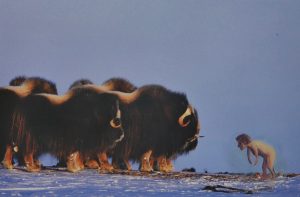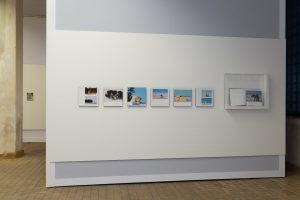Sunaura Taylor
b. 1982, Tucson, Arizona, USA; lives in New York City, USA
Sunaura Taylor is an artist and writer. She holds an MFA in Art Practice from the University of California, Berkeley, and is a PhD candidate in American Studies in the Department of Social and Cultural Analysis at New York University. Taylor is the author of Beasts of Burden: Animal and Disability Liberation (The New Press, 2017), which received the 2018 American Book Award, and has written extensively for American Quarterly, New Labor Forum and Qui Parle, among other outlets. Sunaura Taylor’s artworks have been exhibited at venues such as the CUE Art Foundation, New York and the Smithsonian, Washington, D.C.
CONTRIBUTIONS
Wildlife, 2014
Oil paint on wildlife photography book, approx. 30.5 × 30.5 × 5 cm
Wildlife Wheelchairs: Hairy Wheelchair; Arctic Wheelchair;
Wheelchairs On the Moon, 2014
Watercolour and pen on paper, 12.7 × 20.32 cm
Sunaura Taylor’s paintings open up spaces where disability and animality meet. Embedded in her academic research and activism, they explore the interlaced relationship between techniques of oppression against entities considered less valuable than able-bodied humans, from the violent histories of pathology to factory farming to the climate crisis or the destruction of land and water bodies. For Bergen Assembly, Taylor presents two series of works that depict scenes situated sometime before or after ableism’s hegemonic reign. In Wildlife (2014), she has painted representations of her own naked body onto each page of a wildlife photography book, belonging and binding with what are considered wild animals, from polar bears to wild oxen, to assert their subjectivities within a exponentiated vulnerability in the moment of environmental catastrophe. Her series Wildlife Wheelchairs proposes yet-not or not-anymore impaired landscapes that are inhabited by the medical apparatuses that both support
mobility and become the visual signifier to open up processes of dehumanisation and animalisation. Here, able-bodiedness is understood as a temporal state and wheelchairs become sensory inhabitants of potential sites for aesthetic and political transformation.
RELATED PLATFORMS
Exhibition


